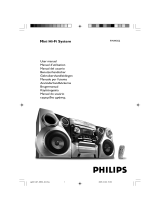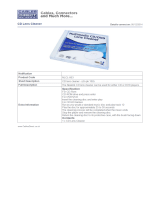Philips MCM119 User manual
- Category
- Home audio sets
- Type
- User manual
This manual is also suitable for
Philips MCM119 is a micro system with a range of features to enhance your music listening experience. It offers versatile connectivity options, including the ability to play music from CDs, MP3-CDs, and USB mass storage devices. With its built-in FM/MW radio tuner, you can enjoy your favorite radio stations. The system also features a clock and timer function, allowing you to wake up to your favorite music or set a timer to turn off the system automatically.
Philips MCM119 is a micro system with a range of features to enhance your music listening experience. It offers versatile connectivity options, including the ability to play music from CDs, MP3-CDs, and USB mass storage devices. With its built-in FM/MW radio tuner, you can enjoy your favorite radio stations. The system also features a clock and timer function, allowing you to wake up to your favorite music or set a timer to turn off the system automatically.




















-
 1
1
-
 2
2
-
 3
3
-
 4
4
-
 5
5
-
 6
6
-
 7
7
-
 8
8
-
 9
9
-
 10
10
-
 11
11
-
 12
12
-
 13
13
-
 14
14
-
 15
15
-
 16
16
-
 17
17
-
 18
18
-
 19
19
-
 20
20
-
 21
21
-
 22
22
-
 23
23
-
 24
24
Philips MCM119 User manual
- Category
- Home audio sets
- Type
- User manual
- This manual is also suitable for
Philips MCM119 is a micro system with a range of features to enhance your music listening experience. It offers versatile connectivity options, including the ability to play music from CDs, MP3-CDs, and USB mass storage devices. With its built-in FM/MW radio tuner, you can enjoy your favorite radio stations. The system also features a clock and timer function, allowing you to wake up to your favorite music or set a timer to turn off the system automatically.
Ask a question and I''ll find the answer in the document
Finding information in a document is now easier with AI
Related papers
-
Philips MCM710/61 Quick start guide
-
Philips MC235B User manual
-
Philips MCM299 Specification
-
Philips MCM298/37 User manual
-
Philips MC230/25 User manual
-
Philips MC235/37 User manual
-
Philips MC235/37B User manual
-
PYLE Audio FWM352/05 User manual
-
Philips MC235B/79 User manual
-
Philips FWM352/79 User manual
Other documents
-
JVC 0410YOMMDWCDT User manual
-
 PYLE Audio FWM352 User manual
PYLE Audio FWM352 User manual
-
Akai QXA6710 Specification
-
 Cables Direct NLCL-003 Datasheet
Cables Direct NLCL-003 Datasheet
-
TEAC PC-D880 Owner's manual
-
Grundig MS 240 Datasheet
-
AGPtek G02 Owner's manual
-
Kompernass KH 2309 User manual
-
Grundig CDS 6580 A SPCD User manual
-
RCF MS1033 Home CD Player Owner's manual

























